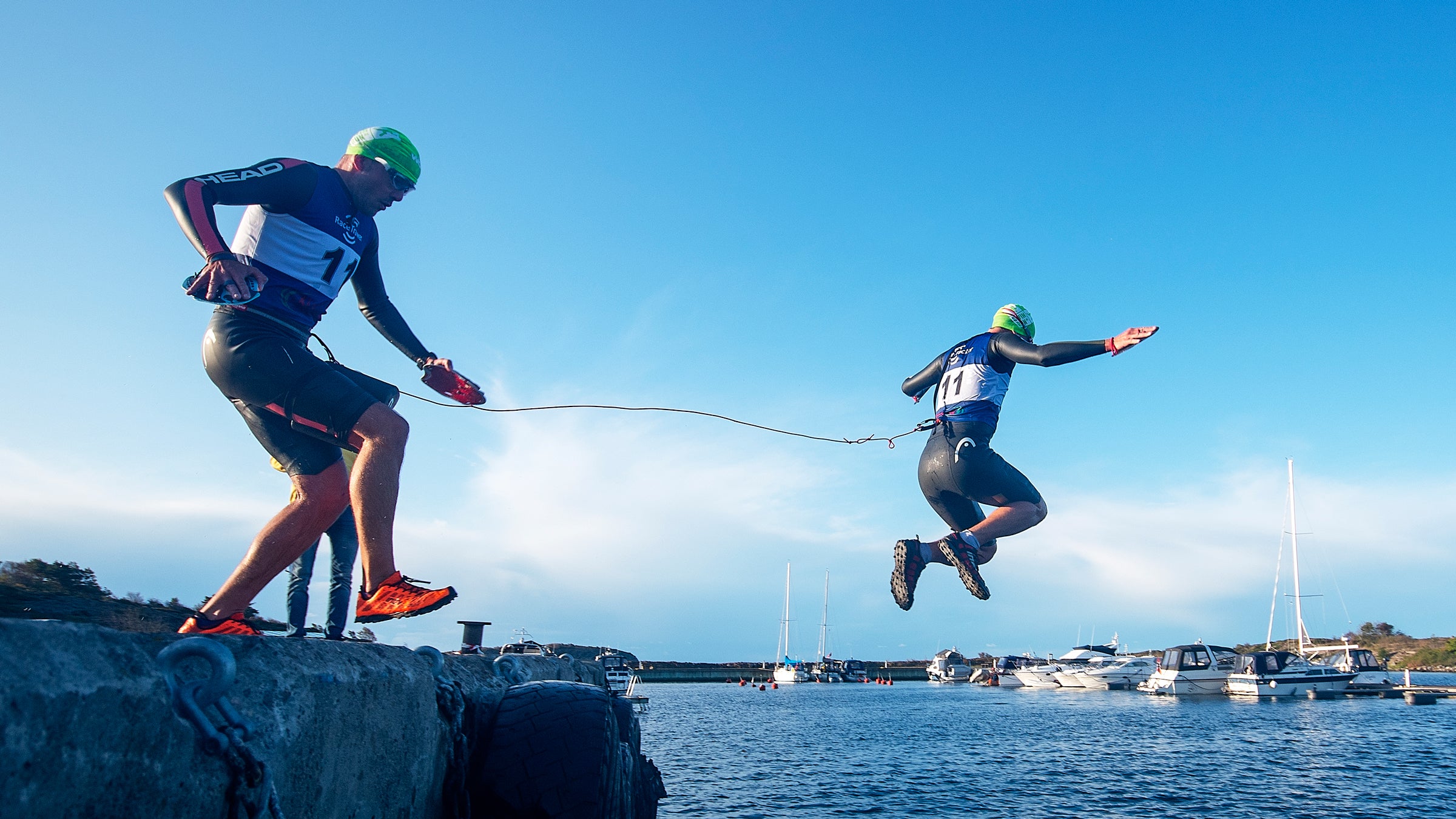What's The Deal With The Swimrun Tether?

Teammates jump into the water at a Swimrun in Norway in 2018.
In this monthly Swimrun column, Chris Douglas and Chipper Nicodemus, a swimrun team out of Northern California and hosts of the Low Tide Boyz – A Swimrun Podcast, will be answering all of your Swimrun questions. This month, they tackle one of the most confusing: What’s a Swimrun tether, why are you tied to your partner, and do you have to have one?
—
A question that we get a lot is some variation of the following: So you swim and run, swim and run over and over—AND you’re attached to each other the whole time? To which our answer is always some variation of, “Yeah, with a tether!” and then insert a pregnant pause for added effect.
In this month’s column, we will demystify the Swimrun tether (or mystify it if this is the first you’re hearing of such a thing), talk about the tactical reasons for using a tether (spoiler alert: it makes you faster), and tie (pun intended) in some funny Swimrun tether stories from guests and fans of the show.
What Is A Swimrun Tether?
The tether, or tow line, is essentially a 3m (or roughly 10ft) cord that Swimrun teams use to stay in contact with each other in the water and land. The genesis for the tether, according to legendary swimrunner Jonas Colting, was to keep teams safe and in contact during the original Ötillö race, which in the early years took teams 18+ hours to finish. While tethers aren’t mandatory at every race, most teams will opt to use one for longer distance events. The majority of teams DIY their Swimrun tethers and we recommend using quick release carabiners to attach it at both ends for, um, quick release. The length of a tether can vary depending on comfort level, but typically you want it just long enough so that you stay on your partner’s feet in the water. (PRO TIP: If the tether is too long during a race, make a knot on the line during the next run leg.) Teams then attach each end to their wetsuit—some suits have integrated loops for attachment—or to a waist utility belt a la Batman. As with anything Swimrun, you should experiment in training to see what works best for you. It definitely takes some getting used to swimming and running with a tether, and dinner plate-sized hand paddles, and a giant pull buoy.
Related:
– Everything to Know Before Attempting a Swimrun
– The Greatest Thing About Swimrun (Spoiler: It’s the Partner Part)
– Never Get Out of the Boat: An Ötillö Catalina Race Report
– Hold My Bike: A Look at the Rapid Growth of Swimrun
– Swimrun: Your Ticket to a Faster Tri
Why Use A Tether?
When you are using a tether, be sure to keep it on all the time. Clipping, unclipping, wrapping the cord up after a 200m swim, pulling it out, having it tangle worse than your iPhone headphones, and then trying to rehook it to your partner who is already charging away will eat up a lot of time. This all comes down to practice and developing the technique to wield the tether effectively.
Does It Ever Backfire?
Using a tether will likely help your team perform better at a race but it also pretty much increases the chance of hilarity ensuing by about 40%, according to an unofficial Löw Tide Böyz survey. You can trip on it, get your paddle caught in it, get it stuck on foliage, etc. It all makes for great race stories and really adds to the Swimrun experience.
We asked our listeners for some of their tales of Swimrun tether mishaps and we weren’t disappointed. According to Mia, tethers can attract wildlife—in her case: ducks. David told us his friend thought the race organizers had put up ropes to help with a difficult swim exit and he ended up pulling the tether and dragging his partner back into the water. Audrey said, “At Casco Bay we saw teams coming out of the water looking like they just harvested enough greens for a nice seaweed salad.” The best story of all was probably from David, who told us about the time he saw a team running full-out go on opposite sides of a lamppost—while tethered. I think we all know how that one ended.
That’s it for this month’s column. Reach out to us with any burning Swimrun questions that you’d like to see answered. Hopefully, we will all be able to go back to racing safely soon but until then, go for a swim with shoes on, then a run, rinse and repeat, and be sure to give that tether a shot. It will change your life!